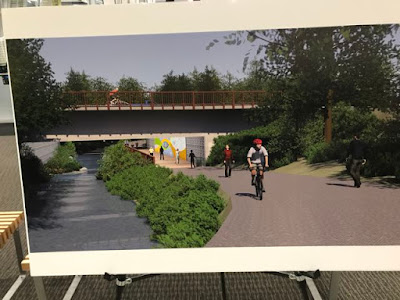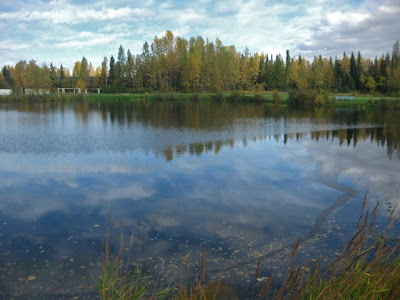 I had lunch with the chair of the Anchorage International Film Festival to catch up on change to how things are being done this year. Here he's checking films on his phone. There have been some significant changes with a non-local Festival Programer who is also a film maker who lives in Norway. Some of that has to do with which films got selected into the festival. There still were local programmers, but the last word went to the Ida.
I had lunch with the chair of the Anchorage International Film Festival to catch up on change to how things are being done this year. Here he's checking films on his phone. There have been some significant changes with a non-local Festival Programer who is also a film maker who lives in Norway. Some of that has to do with which films got selected into the festival. There still were local programmers, but the last word went to the Ida. Also there were no 'films in competition.' All films that were selected are eligible for prizes. But
the juries this year are only partially local. There are also international jurists and the final decisions rest outside of Anchorage.
And Festival Genius is out and GOELevent is in. Those are film festival websites for managing the schedules and online ticketing. I'm just starting to play with GOELevent and there have been some glitches - films that didn't show up when searched and things like that.
Will there be Audience Awards this year? Stay tuned. The board meets Saturday to work out remaining decisions. I did a short video, but I'm having trouble between iMovie and Youtube. Good thing I tried today so I can get this cleared up before the festival starts.
I'll catch up more on this later. It was a beautiful sunny day. A little cooler this morning, but no snow at all and the only ice I saw riding over to lunch was in puddles.
Later I went to Loussac to check out the public meeting on the midtown transportation project. Basically it's focused on the Seward Highway between Tudor and Fireweed. They've been working with some community councils and it's a big, long term project. 36th would go under the Seward Highway, then the highway would go below ground under Benson and Northern Lights.
The more I think about this, the more I think there are better ways to spend half a billion dollars.
The bottom/left is going north, the toplight is going south. The white box on the right side is Midtown Mall (old Sears Mall) and the white boxes on the upper left are Fred Meyer. Seward Highway goes underground just before Benson and comes back up after Northern Lights. They don't have any plans for the large space between the north and south lanes.

This is another view.
But they also said that most of the traffic coming from the south is going to midtown, so there will still be a lot of traffic crossing Tudor, 36th, Benson, Northern Lights, and Fireweed. There were some predictions of increased traffic in the next 20 years, but even with the long light at 36th and Seward Highway, I can still get most places in Anchorage in 15 minutes (except at 5pm when it might take 20 or 25 minutes.
90% of the 1/2 billion dollar price tag would be paid for by the Federal government, or at least that's the plan. I can't help but think that the construction industry is going to be the big winners here and folks in Anchorage will get years of torn up roads and then some marginally improved traffic at the end.
Pedestrians and bikes should come out better with wider trails and easier crossings of the Seward Highway. I don't enjoy crossing the highway on my bike, but I've learned how the lights work and just relax as I wait for them to change. And I watch out for people making right turns when I have the walk sign.
The only part that I endorse 100% is a fix for the tunnel along Chester Creek at Seward Highway. Here's a picture of the tunnel and the pipe for the creek now from the east side. Riding on a bright day, you get into the tunnel and it's hard to see. Even on a gray day. And the creek is reduced to a pipe going under the highway.
This is significantly better for bikes, walkers, joggers, and fish.
The biggest benefit is for people driving north and south through midtown. They won't have to stop for lights. But people going into midtown will have to stop for lights and people on the east-west streets will still have to cope with lights and traffic coming off the highway. Pedestrians get shorter streets to cross (going east and west) but it will now take two lights to get across both directions because the median between north and south lanes will be significantly wider.
I want to see clear estimates for how much time people will save. They mentioned pedestrians who have died in this area crossing streets in the last ten years or so. The speaker (not the slides) went on to say, "That's just non-motorized deaths." Really? These are deaths of pedestrians running into each other? I'm guessing a motorized vehicle was involved in all the pedestrian deaths. How many deaths would prevented if we spent $500 million on Medicaid including much better mental health treatment? A lot more than six I'm sure.
Those are my initial thoughts. More trees along the Midtown mall parking lot would improve things for a lot less, and fixing some sidewalks. I think about the Tudor bridge with the very narrow sidewalks. Why didn't that get reasonable sidewalks from the beginning? Or when they widened the highway more recently?
What corners are they going to cut when funding doesn't match their current dreams? Non-motorized transportation will get shortchanged yet again?
I need to be convinced with more details that show this will
a) indeed improve the flow of traffic significantly
b) make things much easier for pedestrians, bikes, runners, etc.
c) give us more bang for our buck (or more benefit for the cost) than spending money on health care and education.
I do recognize that this money is tied to Federal highway monies, so we can get it for the roads, but not the other areas that probably would see much greater benefits.





















